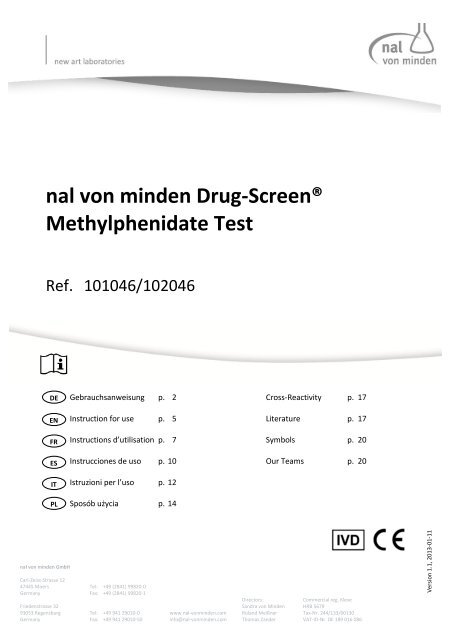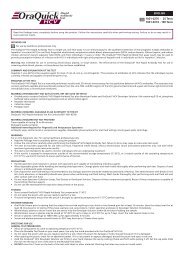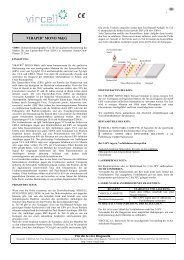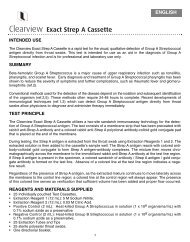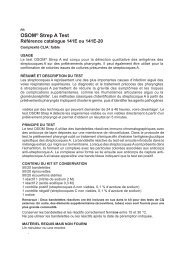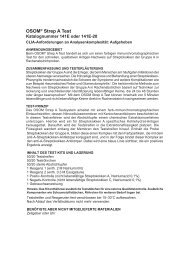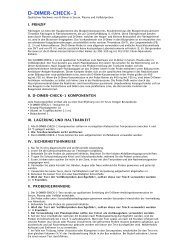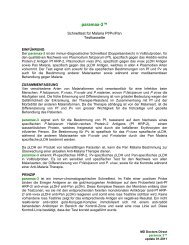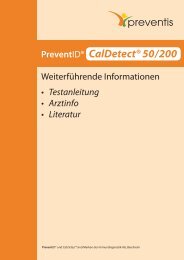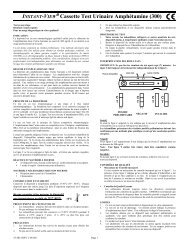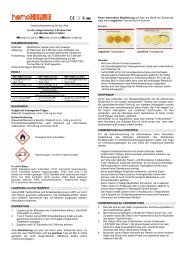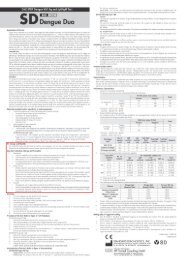nal von minden Drug-Screen® Methylphenidate ... - MD Doctors Direct
nal von minden Drug-Screen® Methylphenidate ... - MD Doctors Direct
nal von minden Drug-Screen® Methylphenidate ... - MD Doctors Direct
Create successful ePaper yourself
Turn your PDF publications into a flip-book with our unique Google optimized e-Paper software.
Version 1.1, 2013-01-11<strong>nal</strong> <strong>von</strong> <strong>minden</strong> <strong>Drug</strong>-<strong>Screen®</strong><strong>Methylphenidate</strong> TestRef. 101046/102046DEENFRESITPLGebrauchsanweisung p. 2Instruction for use p. 5Instructions d’utilisation p. 7Instrucciones de uso p. 10Istruzioni per l’uso p. 12Sposób użycia p. 14Cross-Reactivity p. 17Literature p. 17Symbols p. 20Our Teams p. 20<strong>nal</strong> <strong>von</strong> <strong>minden</strong> GmbHCarl-Zeiss-Strasse 1247445 MoersGermanyFriedenstrasse 3293053 RegensburgGermanyTel: +49 (2841) 99820-0Fax: +49 (2841) 99820-1Tel: +49 941 29010-0Fax: +49 941 29010-50www.<strong>nal</strong>-<strong>von</strong><strong>minden</strong>.cominfo@<strong>nal</strong>-<strong>von</strong><strong>minden</strong>.com<strong>Direct</strong>ors:Sandra <strong>von</strong> MindenRoland MeißnerThomas ZanderCommercial reg. KleveHRB 5679Tax-Nr. 244/133/00130VAT-ID-Nr. DE 189 016 086
DEUTSCH<strong>nal</strong> <strong>von</strong> <strong>minden</strong> <strong>Drug</strong>-<strong>Screen®</strong> <strong>Methylphenidate</strong> Test1. AnwendungsbereichDer <strong>nal</strong> <strong>von</strong> <strong>minden</strong> <strong>Drug</strong>-<strong>Screen®</strong> <strong>Methylphenidate</strong> Schnelltestist ein immunochromatographischer Schnelltest für diequalitative Bestimmung <strong>von</strong> Methylphenidat (MPD) in humanemUrin bei einem Cut-off-Wert <strong>von</strong> 300 ng/ml. Er kann alsHilfsmittel zur Einleitung oder Beobachtung <strong>von</strong> therapeutischenMaßnahmen verwendet werden.Der Schnelltest ist ein in vitro Diagnostikum für den professionellenGebrauch. Der Test liefert nur ein visuelles, qualitativesund vorläufig a<strong>nal</strong>ytisches Resultat. Um ein sicheres a<strong>nal</strong>ytischesResultat zu erhalten, muss eine weitere, spezifischerechemische Methode angewendet werden. Gaschromatographie/Massen-spektrometrie(GC/MS) oder Flüssigkeitschromatografie/Massenspektroskopie (LC/MS) sind die bevorzugtenBestätigungsmethoden. Klinische Überlegungen und fachlichesUrteil sollten bei jedem Testresultat auf Alkoholmissbrauchangewendet werden, besonders bei vorläufig positivenErgebnissen.2. EinleitungMethylphenidat ist hauptsächlich unter dem MarkennamenRitalin® <strong>von</strong> Novartis bekannt, das ein Racematgemisch mitschnell einsetzender Wirkung ist. Es gibt außerdem eineVielzahl <strong>von</strong> Formulierungen und generischen Markennamen.Methylphenidat ist ein Psychostimulans zur Behandlung <strong>von</strong>Aufmerksamkeits-Defizit-Hyperaktivitäts-Störung, Posturalorthostatische Tachykardie-Syndrom und Narkolepsie.Methylphenidat kann auch bei behandlungsresistenter Lethargie,Depression, zur Behandlung in therapieresistentenFällen <strong>von</strong> Lethargie, Depression, neuralen Schäden, Fettleibigkeitund selten für andere psychiatrische Erkrankungen wieZwangsstörungen verschrieben werden. <strong>Methylphenidate</strong>rhöht, genau wie andere Stimulanzien die Dopaminausschüttung.Der Missbrauch Potential <strong>von</strong> Methylphenidatsteigt, wenn Methylphenidat zerkleinert und geschnupft oder,injiziert wird, wobei die Wirkung ähnlich der <strong>von</strong> Kokain ist.Kokain-ähnliche Effekte können auch auftreten, wenn sehrhohe Dosen Methylphenidat oral eingenommen werden.Methylphenidat hat ein hohes Potenzial zu Drogenabhängigkeitund Missbrauch zu führen, aufgrund der ähnlichenpharmakologischen Struktur zu Kokain und Amphetamine.Internatio<strong>nal</strong> ist Methylphenidat als Schedule II Droge nachdem Übereinkommen über psychotrope Stoffe eingestuft. Inden Vereinigten Staaten wird das Methylphenidat Droge alsSchedule II kontrollierten Substanz, die Bezeichnung fürSubstanzen, die eine anerkannte medizinische Wert haben,aber stellen eine hohe Wahrscheinlichkeit für Missbrauchwegen ihrer Suchtpotenzial verwendet eingestuft.3. TestprinzipAlle <strong>nal</strong> <strong>von</strong> <strong>minden</strong> <strong>Drug</strong> <strong>Screen®</strong> Drogenschnelltests funktionierennach dem gleichen, bewährten Prinzip. Die Patientenprobewird auf das Sammelpad aufgebracht und wandertdurch Kapillarkräfte auf dem Teststreifen entlang. Im Falleeiner negativen Probe erreichen freie, Gold-konjugierteAntikörper die Testregion. Hier wurde die Zielsubstanz (indiesem Fall Methylphenidat) auf dem Teststreifen immobilisiert.Methylphenidat wird <strong>von</strong> den gold-konjugierten Antikörpernerkannt und gebunden. Damit akkumulieren Goldpartikelan der T-Linie und erzeugen eine rote Linie bei negativemBefund. Enthält die Probe Methylphenidat wird dieses bereitsim Konjugatpad <strong>von</strong> Gold-konjugierten Antikörpern gebunden.Liegt die Drogenkonzentration der Patientenprobe oberhalbdes Cut-Offs des Teststreifens sind alle Bindungsplätze derAntikörper abgesättigt und Methylphenidat kann an der T-Linie nicht mehr binden. Daher bleibt bei positiven Probenoberhalb des Cut-Offs die Bildung einer T-Linie aus. In jedemFall erreichen Gold-Konjugate die Kontrollregion und werdendort <strong>von</strong> Antikörpern auf der Membran gebunden. Somitakkumulieren in jedem Fall Goldpartikel an der C-Linie, wasimmer zur Bildung einer roten Kontrollbande führt.4. Bestandteile der TestpackungTauchtest Einzeln verpackte Teststreifen GebrauchsanweisungKassettentest Einzeln verpackte Testkassette mit einer Kunststoffpipette Gebrauchsanweisung5. Zusätzlich benötigte Materialien Stoppuhr Handschuhe Sammelgefäß für Urin6. Haltbarkeit und Lagerung der ReagenzienDer <strong>nal</strong> <strong>von</strong> <strong>minden</strong> <strong>Drug</strong>-<strong>Screen®</strong> Methylphenidat Schnelltestkann bei Zimmertemperatur oder gekühlt (2-30°C) bei normalerLuftfeuchtigkeit gelagert werden. Verwenden Sie die Testsnicht mehr nach Ablauf des aufgedruckten Haltbarkeitsdatums.Das Produkt ist feuchtigkeitsempfindlich und solltesofort nach Öffnen der Verpackung verbraucht werden. Testsmit beschädigten Beuteln müssen entsorgt werden.7. Warnungen und Vorsichtsmaßnahmen Nur für den einmaligen in-vitro diagnostischen Gebrauch. Nur für den professionelle Einsatz. Die den Test enthaltende Folienverpackung sollte versiegeltsein. Entsorgen Sie den Test, wenn die Verpackung beschädigtist. Nur Urinproben verwenden – keine anderen Flüssigkeiten. Proben nicht in das Reaktionsfeld (Ergebnisfeld) geben. Urinproben können ggf. infektiös sein. Daher sollten angemesseneVorkehrungen für ihre Handhabung und Entsorgunggetroffen werden. Bitte berücksichtigen Sie bei der Bewertung des Ergebnissesmögliche Kreuzreaktionen. Lagern und transportieren Sie den Test stets bei 2-30°C. Die Komponenten des Tests (z.B. Antikörper/Chemikalien)verursachen keinerlei Risiken sofern der Test gemäß derGebrauchsanweisung durchgeführt wird.8. Probennahme, -Vorbereitung und LagerungUrinproben werden in einem Plastik- oder Glasbehältergesammelt. Wenn die Probe nicht sofort a<strong>nal</strong>ysiert werdenkann, ist es möglich, sie für 3 Tage gekühlt zu lagern. Wenneine längere Lagerung notwendig ist, sollten die Probeneingefroren und vor Gebrauch aufgetaut werden. Die Probensollten vor dem Testen auf Raumtemperatur (18-25°C) gebrachtwerden Die pipettierten Proben sollten frei <strong>von</strong> grobenVerunreinigungen sein. Es wird empfohlen, sehr trübe Proben<strong>nal</strong> <strong>von</strong> <strong>minden</strong> GmbH • Carl-Zeiss-Strasse 12 • 47445 Moers • Germany • info@<strong>nal</strong>-<strong>von</strong><strong>minden</strong>.com • www.<strong>nal</strong>-<strong>von</strong><strong>minden</strong>.com 2
DEUTSCH<strong>nal</strong> <strong>von</strong> <strong>minden</strong> <strong>Drug</strong>-<strong>Screen®</strong> <strong>Methylphenidate</strong> TestInterferenztestDie Testleistung beim Cut-off-Wert ist nicht beeinträchtigt,wenn der pH-Wert zwischen 5 und 8 und das spezifischeGewicht zwischen 1.005 und 1.035 liegt.Folgende Substanzen wurden getestet. Keine beeinträchtigteden <strong>nal</strong> <strong>von</strong> <strong>minden</strong> <strong>Drug</strong>-<strong>Screen®</strong> <strong>Methylphenidate</strong> Schnelltestbei den aufgeführten Konzentrationen:SubstanzKonzentration (ng/ml)Glucose 2000Huma<strong>nal</strong>bumin 2000Human Hämoglobin 10Urea 4000Harnsäure 10Rev 0, 2012-11-27 RW<strong>nal</strong> <strong>von</strong> <strong>minden</strong> GmbH • Carl-Zeiss-Strasse 12 • 47445 Moers • Germany • info@<strong>nal</strong>-<strong>von</strong><strong>minden</strong>.com • www.<strong>nal</strong>-<strong>von</strong><strong>minden</strong>.com 4
ENGLISH<strong>nal</strong> <strong>von</strong> <strong>minden</strong> <strong>Drug</strong>-<strong>Screen®</strong> <strong>Methylphenidate</strong> Test1. Intended UseThe <strong>nal</strong> <strong>von</strong> <strong>minden</strong> <strong>Drug</strong>-<strong>Screen®</strong> <strong>Methylphenidate</strong> Test is achromatographic immunoassay for the qualitative determinationof <strong>Methylphenidate</strong> in human urine at a cut-off value of300 ng/ml. It can be used as an aid to the diagnosis andtherapeutic treatments offered by physicians.The visual rapid test is designed for professio<strong>nal</strong> use as an invitro diagnostic to provide a preliminary qualitative anda<strong>nal</strong>ytical result. A more specific chemical method must beused for the confirmation of results. Gas chromatography/massspectrometry (GC/MS) or Liquid chromatography/massspectrometry (LC/MS) are the preferred methods.Clinical and professio<strong>nal</strong> judgement should be exercised wheninterpreting any substance of abuse test result, particularlywhen the preliminary test result is positive.2. Introduction<strong>Methylphenidate</strong> is most commonly known by the Novartistrademark name Ritalin®, which is an instant-release racemicmixture. There also exists a variety of formulations andgeneric brand names. The <strong>Methylphenidate</strong> drug is apsychostimulant drug for the treatment of attention-deficithyperactivity disorder, Postural Orthostatic TachycardiaSyndrome, and narcolepsy. The methylphenidate drug mayalso be prescribed for off-label use in treatment-resistantcases of lethargy, depression, neural insult, obesity, and rarelyfor other psychiatric disorders such as Obsessive-CompulsiveDisorder. The methylphenidate drug, like other stimulants,increases dopamine levels. The abuse potential of themethylphenidate drug is increased when the methylphenidatedrug is crushed and snorted or when it is injected producingeffects almost identical to the cocaine drug. Cocaine-likeeffects can also occur with very large doses of themethylphenidate drug taken orally. The methylphenidate drughas a high potential for drug dependence and addictive abusedue to its similar pharmacological connection to cocaine andamphetamines. Internatio<strong>nal</strong>ly, the methylphenidate drug is aSchedule II drug under the Convention on PsychotropicSubstances.3. Principle of the TestAll <strong>nal</strong> <strong>von</strong> <strong>minden</strong> <strong>Drug</strong> <strong>Screen®</strong> <strong>Drug</strong> Rapid Tests are basedon the same, proven test principle. The patient sample isapplied to the collection pad and moves along the test strip bycapillary forces. In case of a negative sample, free, goldconjugatedantibodies reach the test region where the targetsubstance (in this case <strong>Methylphenidate</strong>) is immobilized onthe test strip. <strong>Methylphenidate</strong> is recognized and bound bythe gold-conjugated antibodies. In this way, gold particlesaccumulate on the T-line causing a red line to become visiblein case of a negative result. If <strong>Methylphenidate</strong> is present inthe sample, it is bound by the gold-conjugated antibodiesalready in the conjugate pad. If the <strong>Methylphenidate</strong> concentrationin the patient sample is higher than the cut-off level ofthe test strip all binding sites are occupied and <strong>Methylphenidate</strong>cannot be bound on the T-line. This means, that in thecase of a positive sample above the Cut off level, the T-Linewill not appear. In any case, gold-conjugates will reach thecontrol region where they will be bound by antibodies on themembrane. The gold particles will always accumulate on theC-line causing the creation of a red control line.4. Material SuppliedDip Test Single-packed test strip Instructions for useCassette Test Single-packed test cassettes with a plastic pipette Instructions for use5. Additio<strong>nal</strong> required Material Timer Gloves Urine Cup6. Storage and StabilityThe <strong>nal</strong> <strong>von</strong> <strong>minden</strong> <strong>Drug</strong>-<strong>Screen®</strong> <strong>Methylphenidate</strong> rapidtests can be stored at room temperature or refrigerated (2-30°C) at normal humidity. Do not use the tests beyond theexpiry date. The product is sensitive to humidity and should beused shortly after opening the individual package. Tests fromdamaged packages should be disposed of.7. Warnings and Precautions For in vitro diagnostic use only. To be used by medical professio<strong>nal</strong>s only. The test should be in a sealed pouch. When the package isdamaged dispose of the test. For urine samples only – do not use other sample material. Do not drop any sample into the reaction zone (resultwindow). Urine samples can be infectious. Therefore the cleanhandling and secure storage of test strips is recommended. Store and transport the tests between 2-30°C. The test components (e.g. antibody/chemicals) do notcause any risks when processed accordingly.8. Specimen Collection and PreparationUrine samples may be collected in plastic or glass containers.If the sample cannot be a<strong>nal</strong>ysed immediately, it can be storedrefrigerated for up to 3 days. For a longer storage period keepthe sample frozen and then thaw before use. Samples shouldbe brought to a room temperature of 18-25°C for testing.Samples with high turbidity should be centrifuged beforea<strong>nal</strong>ysis. Urine samples within the normal pH range of 5-8 canbe tested without any pre-treatment. Fresh and properlystored urine samples generally are within this range. Adulterationmay cause false results. If sample adulteration is suspected,obtain a new sample and forward both samples to thelaboratory for testing.Handle all urine specimens as if they are potentially infectious.9. Procedure of the TestDip Test:1. Remove the test from its packaging. Bring the urine sampleto room temperature before performing the test.2. Immerse the strip in the urine until a reddish colour appearsin the test area (for approximately 30 to 60 seconds);<strong>nal</strong> <strong>von</strong> <strong>minden</strong> GmbH • Carl-Zeiss-Strasse 12 • 47445 Moers • Germany • info@<strong>nal</strong>-<strong>von</strong><strong>minden</strong>.com • www.<strong>nal</strong>-<strong>von</strong><strong>minden</strong>.com 5
ENGLISH<strong>nal</strong> <strong>von</strong> <strong>minden</strong> <strong>Drug</strong>-<strong>Screen®</strong> <strong>Methylphenidate</strong> Testbe sure that the edge of the plastic does not touch theurine.3. Place the test strip on a clean and even surface.4. Wait approximately 8-10 minutes before reading the results.Do not evaluate results after 20 minutes, as they areno longer valid.Cassette Test:1. Remove the test from its packaging. Bring the urine sampleto room temperature before performing the test.2. Transfer 3 drops of urine (about 120- 150 μl) into the sampleopening of the test cassette. Make sure that the urinedoes not come into contact with other areas of the test.3. Read the results after 8-10 minutes. Do not evaluate resultsafter 20 minutes, as they are no longer valid.10. Interpretation of the ResultsThe test zone (T) detects drug substances found in the urinesample, the remaining zone (C) is the control zone. With a negative result, and therefore a drug-free urinesample, a pink stripe will appear in both the test zone (T)and in the control zone (C). With a positive result a pink stripe will only appear in thecontrol zone (C).If the control region (C) has no distinguishable line, the test isinvalid!Dip Test:Negative Positive InvalidCassette TestThe test zone (T) will detect the presence of the specifieddrugs in the urine. The control zone is the area labeled (C) With a negative result, a drug-free urine sample, a pinkstripe will appear in test zone (T) as well as a pink strip inthe control area (C) With a positive result a pink strip will only appear in thecontrol area (C)If no strip appears in the control zone (C) example test isinvalid!Negative Positive InvalidNoteThe intensity of the color stripe on the test field can varydepending on the parameters that are being tested. It is onlywhen no stripe appears that the test is positive. Positiveresults should be confirmed by an additio<strong>nal</strong> testing method(GC/MS).11. Quality ControlGood laboratory practice (GLP) suggests the use of controlspecimens to ensure proper test performance. Control materialcan be purchased in specialized trade and should be useddaily. The test procedure with control material does not differfrom the procedure with sample. Controls should challengethe test and have a concentration level near the cut-off. Whencontrol results are not within a specified range the test resultsare invalid. The user should comply with all federal, state, andlocal laws, guidelines and regulations.With the control line (C) the <strong>nal</strong> <strong>von</strong> <strong>minden</strong> <strong>Drug</strong>-<strong>Screen®</strong><strong>Methylphenidate</strong> test has an integrated process control. Thecontrol line is formed because of an antigen/antibody reactionand must always appear independent from drug and metaboliteconcentrations in the sample. When no control lineappears the test is invalid and must be disposed of. Thecontrol line is used for confirmation that enough samplematerial has been added and the test performance wascorrect.12. Test PerformanceSensitivitiyThe cut-off concentration (sensitivity level) of the <strong>nal</strong> <strong>von</strong><strong>minden</strong> <strong>Drug</strong>-<strong>Screen®</strong> <strong>Methylphenidate</strong> Rapid Test is determinedto be 300 ng/ml.AccuracyThe accuracy of the <strong>nal</strong> <strong>von</strong> <strong>minden</strong> <strong>Drug</strong>-<strong>Screen®</strong><strong>Methylphenidate</strong> was evaluated in MPD spiked urine specimens.Forty (40) MPD urine specimens were spiked with<strong>Methylphenidate</strong> from 50 to 1500 ng/ml. 30 samples with<strong>Methylphenidate</strong> concentrations between 450 and1500 ng/ml were all found positive (100% agreement), 10samples with <strong>Methylphenidate</strong> concentrations between 50and 150 ng/ml were found negative.Interference TestingThe <strong>Methylphenidate</strong> test performance at cut-off level is notaffected when pH and specific gravity ranges of urine are at5.0 to 8.0 and 1.005 to 1.035.The following substances were tested and confirmed not tointerfere with the <strong>nal</strong> <strong>von</strong> <strong>minden</strong><strong>Drug</strong>-<strong>Screen®</strong> <strong>Methylphenidate</strong>rapid test at the listed concentrations:SubstanceConcentration (ng/ml)Glucose 2000Human albumine 2000Human hemoglobin 10Urea 4000Uric Acid 10<strong>nal</strong> <strong>von</strong> <strong>minden</strong> GmbH • Carl-Zeiss-Strasse 12 • 47445 Moers • Germany • info@<strong>nal</strong>-<strong>von</strong><strong>minden</strong>.com • www.<strong>nal</strong>-<strong>von</strong><strong>minden</strong>.com 6
FRANÇAIS<strong>nal</strong> <strong>von</strong> <strong>minden</strong> <strong>Drug</strong>-<strong>Screen®</strong> <strong>Methylphenidate</strong> Test1. Domaine d’applicationLe test <strong>nal</strong> <strong>von</strong> <strong>minden</strong> <strong>Drug</strong>-<strong>Screen®</strong> <strong>Methylphenidate</strong> est untest rapide immunochromatographique pour un diagnostic invitro. Il permet la détection qualitative du Méthylphénidate(MPD) dans les urines humaines à un seuil de détection de300 ng/ml. Il peut être utilisé comme aide à l'introduction ou àl'observation de mesures thérapeutiques.Le test rapide est un outil de diagnostic in vitro uniquementpour une utilisation professionnelle. Le test ne fournit qu'unrésultat a<strong>nal</strong>ytique visuel, qualitatif et préliminaire. Il estconseillé d’employer une autre méthode chimique plusspécifique afin d'obtenir un résultat quantitatif de confirmation.La chromatographie gazeuse associée à la spectrométriede masse (GC/MS) ou la chromatographie liquide associée à laspectrométrie de masse (LC/MS) sont les méthodes de confirmationpréférentielles. Il faut faire usage des réflexionscliniques et de l'avis d'un spécialiste pour chaque résultat detest en relation avec un abus d'alcool, surtout en cas derésultats préliminaires positifs.2. IntroductionLe méthylphénidate est plus communément connu sous lenom de Ritaline® commercialisé par la société Novartis et quiest un mélange racémique à effet immédiat. Il existeégalement une variété de marques génériques oumédicaments commerciaux. Le méthylphénidate est unmédicament psychotrope pour le traitement du trouble dudéficit de l’attention avec hyperactivité ainsi que du syndromede tachycardie orthostatique posturale (POTS) et de lanarcolepsie. Le méthylphénidate peut également être prescritpour une utilisation non indiquée dans des cas de résistancesaux traitements de léthargie, de dépression, d’obésité etrarement pour d’autres troubles psychiatriques comme letrouble obsessionnel compulsif (TOC). Le méthylphénidate,comme d’autres stimulants, augmente le niveau de dopamine.L’abus potentiel de méthylphénidate est augmenté lorsquecelui-ci est écrasé puis inhalé ou lorsqu’il est injecté et procureles mêmes effets que la cocaïne. Ces effets peuventégalement être obtenus en ingérant oralement une très fortedose de méthylphénidate. Ce médicament peut provoquerune forte dépendance aux drogues et médicaments du fait deses propriétés pharmacologiques similaires avec la cocaïne oul’amphétamine. Au niveau internatio<strong>nal</strong>, le méthylphénidatefait partie des psychotropes inclus dans le tableau II de laconvention sur les substances psychotropes et aux Etats-Unisil est inscrit au tableau II de la loi relative aux substancesplacées sous contrôle qui désigne les substances ayant unevaleur médicale reconnue mais présentant une forteprobabilité de dépendance.3. Principe du testTous les tests rapides de dépistage de stupéfiants <strong>Drug</strong><strong>Screen®</strong> de <strong>nal</strong> <strong>von</strong> <strong>minden</strong> fonctionnent sur le même principe.L'échantillon du patient est déposé sur la surface derecueil et migre par capillarité le long de la bandelette contenuedans la cassette. En cas d’échantillon négatif, les conjuguésanticorps-particules d’or se déplacent vers la zone detest. La substance ciblée (MPD) est immobilisée sur la bandelette.Le MPD est reconnu et lié par des conjugués anticorpsparticulesd’or. Ainsi, les particules d'or s'accumulent auniveau de la ligne T et forment une ligne rouge indiquant unrésultat négatif. Si l’échantillon contient du MPD, il sera déjàlié sur la surface de recueil par des conjugués anticorpsparticulesd’or. Si la concentration de la substance recherchéedans l'échantillon du patient est supérieure au seuil dedétection de la bandelette, tous les sites de liaison desanticorps sont saturés et le MPD ne peut plus se lier au niveaude la ligne T. Pour cette raison, les échantillons positifssupérieurs au seuil de détection ne laissent pas apparaître deligne T. Dans tous les cas, le conjugué d'or atteint la zone decontrôle où il est fixé à la membrane par des anticorps. Ainsi,des particules d'or s'accumulent dans tous les cas au niveau dela ligne C, ce qui conduit toujours à la formation d'une ligne decontrôle rouge.4. Réactifs et matériel fourniBandelette de test Bandelette de test emballée individuellement Mode d'emploiCassette de test Cassettes emballées individuellement avec une pipetteplastique Mode d'emploi5. Matériel supplémentaire nécessaire Chronomètre Gants Récipient pour l'urine6. Conservation et stockageLa test <strong>Drug</strong>-<strong>Screen®</strong> de <strong>nal</strong> <strong>von</strong> <strong>minden</strong> peut être conservé àtempérature ambiante ou au réfrigérateur (2–30°C) avec unehumidité d'air normale. Ne plus utiliser les tests après expirationde la date limite de conservation indiquée. Le produit estsensible à l'humidité et doit être utilisé immédiatement aprèsouverture de son emballage. Les tests dont l'emballage estendommagé doivent être éliminés.7. Avertissements et précautions Seulement pour une utilisation unique in vitro. Usage professionnel uniquement. L'emballage plastique contenant le test doit être scellé.Éliminer le test si l'emballage est endommagé. N'utiliser que des échantillons d'urine - pas d'autres fluides. Ne pas mettre l'échantillon dans la fenêtre réactive (fenêtrede résultat). Les échantillons d'urine peuvent éventuellement êtreinfectieux. Par conséquent, il faut prendre des mesurespréventives adéquates pour leur maniement et leurélimination. Toujours conserver et transporter le test entre 2 et 30°C. Les composants du test (par exemple les anticorps/produitschimiques) ne représentent aucun risque tant que le testest exécuté conformément au mode d'emploi.8. Recueil, préparation et conservation des échantillonsLes échantillons d'urine sont recueillis dans un récipient enplastique ou en verre. Lorsque l'échantillon ne peut pas êtrea<strong>nal</strong>ysé immédiatement, il est possible de le conserver auréfrigérateur pendant 3 jours. Si une conservation plus longueest nécessaire, congeler les échantillons et les décongeler<strong>nal</strong> <strong>von</strong> <strong>minden</strong> GmbH • Carl-Zeiss-Strasse 12 • 47445 Moers • Germany • info@<strong>nal</strong>-<strong>von</strong><strong>minden</strong>.com • www.<strong>nal</strong>-<strong>von</strong><strong>minden</strong>.com 7
FRANÇAIS<strong>nal</strong> <strong>von</strong> <strong>minden</strong> <strong>Drug</strong>-<strong>Screen®</strong> <strong>Methylphenidate</strong> Testavant utilisation. Il faut amener les échantillons à températureambiante (18-25°C) avant de les tester. Les échantillonspipetés ne doivent pas contenir de grosses particules dedépôt. Il est recommandé de centrifuger les échantillons trèstroubles avant l'a<strong>nal</strong>yse. Une urine avec un pH entre 5 et 8peut être utilisée sans préparation. Les échantillons d'urine,frais et correctement conserves, sont normalement dans cetteplage de pH. L'adultération de l'échantillon d'urine peutprovoquer des résultats erronés. Si une adultération estsoupçonnée, il faut prendre un autre échantillon et a<strong>nal</strong>yserles deux échantillons en laboratoire.Tous les échantillons d'urine doivent être considérés commepotentiellement infectieux et manipulés de la sorte.9. Exécution du testBandelette de test1. Sortir le test de son emballage. Les tests ainsi que leséchantillons d'urine conservés au frais doivent d'abord êtreamenés à température ambiante.2. Tremper la bandelette dans l´urine pendant 30-60secondes; la partie en plastique ne doit pas entrer encontact avec l´urine3. Lire les résultats après 8-10 minutes. Ne pas interpreter lesrésultats après 20 minutesCassette de test1. Sortir le test de son emballage. Les tests ainsi que leséchantillons d'urine conservés au frais doivent d'abord êtreamenés à température ambiante.2. Déposer 3 gouttes d'urine (environ 120-150 μl d'urine)dans le puits. Veillez à ce que l’urine ne rentre pas en contactdirect avec la fenêtre de résultat.3. Lire les résultats après 8-10 minutes. Ne plus lire de résultatsaprès 20 minutes.10. Interprétation des résultatsAu niveau de la zone de réaction, se trouvent les zones de test(T) et les zones de contrôle. (C). Pour un résultat négatif, donc réalisé sur un échantillond’urine ne contenant pas de drogue, une ligne de couleurrose apparaîtra dans la zone de test (T) ainsi que dans lazone de contrôle (C). Pour un résultat positif, une seule ligne apparaît dans lazone de contrôle (C).Si aucune ligne n’apparaît dans la zone de contrôle (C), le testest considéré comme non valide.Bandelette de test:Négatif Positif Non valideCassette de test:Négatif Positif Non valideIndicationL’intensité de la couleur de la bandelette sur la membrane dutest peut être différente selon les paramètres unitaires. Le testest positif seulement quand aucune ligne n’apparaît. Lesrésultats positifs et douteux devront être confirmés par unedeuxième méthode d’a<strong>nal</strong>yse (par exemple GC/MS).11. Contrôle qualitéLes bonnes pratiques de laboratoire recommandentl'utilisation de solutions de contrôle afin de garantir le bonfonctionnement du kit de test. Les contrôles de qualité sontdisponibles dans le commerce spécialisé et leur utilisationrégulière est recommandée. L'exécution du test avec lematériel de contrôle se fait comme avec un échantillond'urine. Les contrôles doivent vérifier la performance du testet avoir une concentration proche de son seuil de détection.Tant que les résultats des contrôles ne se situent pas dans lesvaleurs établies, les résultats de test sont non-valides. Lesutilisateurs doivent suivre les directives natio<strong>nal</strong>es, régio<strong>nal</strong>eset locales en ce qui concerne les contrôles de qualité externes.Les tests <strong>Drug</strong>-<strong>Screen®</strong> de <strong>nal</strong> <strong>von</strong> <strong>minden</strong> offrent déjà avec laligne de contrôle (C) un contrôle de procédé intégré. La lignede contrôle apparaît grâce à une réaction antigène/anticorpsindépendante et doit toujours apparaître que la substancetestée soit présente ou non dans l'échantillon. Si la ligne decontrôle n'apparaît pas, alors le test doit être éliminé.L'apparition de la ligne de contrôle sert à mettre en évidenceque le fluide testé a été déposé en quantité suffisante et quele processus fonctionne parfaitement.12. Performances du testSensibilitéLe cut-off (seuil de détection) du test rapide <strong>nal</strong> <strong>von</strong> <strong>minden</strong><strong>Drug</strong>-<strong>Screen®</strong> <strong>Methylphenidate</strong> a été fixé à 300 ng/ml.PrécisionLa précision du test rapide <strong>nal</strong> <strong>von</strong> <strong>minden</strong> <strong>Drug</strong>-<strong>Screen®</strong><strong>Methylphenidate</strong> a été évaluée avec des échantillons d’urinecontenant du MPD. Quarante (40) échantillons d’urine ont étémélangés avec du Méthylphénidate avec des doses comprisesentre 50 et 1500 ng/ml. 30 échantillons dont les concentrationsen Méthylphénidate se situaient entre 450 et1500 ng/ml furent tous positifs (100 % de concordance). 10échantillons dont les concentrations en Méthylphénidate sesituaient entre 50 et 150 ng/ml furent tous négatifs.<strong>nal</strong> <strong>von</strong> <strong>minden</strong> GmbH • Carl-Zeiss-Strasse 12 • 47445 Moers • Germany • info@<strong>nal</strong>-<strong>von</strong><strong>minden</strong>.com • www.<strong>nal</strong>-<strong>von</strong><strong>minden</strong>.com 8
FRANÇAIS<strong>nal</strong> <strong>von</strong> <strong>minden</strong> <strong>Drug</strong>-<strong>Screen®</strong> <strong>Methylphenidate</strong> TestPerformance du testLa performance du test Methylphénidate au niveau du seuilde détection n’est pas affectée quand le pH et la densité del’urine sont situés respectivement entre 5.0 et 8.0 et entre1.005 et 1.035.Les substances suivantes ont été testées et aucune interférencen’a été constatée avec le test rapide <strong>nal</strong> <strong>von</strong> <strong>minden</strong><strong>Drug</strong>-<strong>Screen®</strong> Methylphénidate aux concentrations indiquées.SubstanceConcentration (ng/ml)Glucose 2000L'albumine sérique humaine 2000L'hémoglobine humaine 10Urée 4000L'acide urique 10Rev. 0, 2013-01-11 JV<strong>nal</strong> <strong>von</strong> <strong>minden</strong> GmbH • Carl-Zeiss-Strasse 12 • 47445 Moers • Germany • info@<strong>nal</strong>-<strong>von</strong><strong>minden</strong>.com • www.<strong>nal</strong>-<strong>von</strong><strong>minden</strong>.com 9
ESPAÑOL<strong>nal</strong> <strong>von</strong> <strong>minden</strong> <strong>Drug</strong>-<strong>Screen®</strong> <strong>Methylphenidate</strong> Test1. Uso previstoEl test de <strong>nal</strong> <strong>von</strong> <strong>minden</strong> <strong>Drug</strong>-<strong>Screen®</strong> <strong>Methylphenidate</strong> esun test inmunocromatográfico de un solo paso in vitro. Estádiseñado para la determinación cualitativa metilfenidato(MPD) en orina humana, con un punto de corte de 300 ng/ml.Puede servir como medio de ayuda para la realización osupervisión de medidas terapéuticas. El test rápido es undiagnóstico in vitro de uso profesio<strong>nal</strong>.El test rápido es un diagnóstico in vitro de uso profesio<strong>nal</strong>.Este test proporciona sólo un análisis preliminar, pararesultados más precisos y legalmente válidos se debe llevar acabo un método de análisis más específico. Los métodospreferidos son la cromatografía de gases-masa (CG/MS) olíquida (LC/MS). En cualquier resultado sobre abuso de alcoholdeben aplicarse siempre un criterio profesio<strong>nal</strong> y tenerse encuenta consideraciones clínicas, especialmente en el caso deun resultado positivo preliminar.2. IntroducciónEl metilfenidato se conoce comúnmente con la marcaregistrada por Novartis, Ritalin, el cual es una mezcla racémicade liberación instantánea. También existe una variedad deformulaciones y nombres de marca genéricos. La drogametilfenidato es un psicoestimulante para el tratamiento dedéficits de atención, hiperactividad, síndrome de taquicardiaortostática postural y narcolepsia. También puede serprescrito para casos de resistencia a tratamientos de fatiga,depresión, insulto neuro<strong>nal</strong>, obesidad y ocasio<strong>nal</strong>mente paraotros trastornos psiquiátricos como por ejemplo el Trastornocompulsivo-obsesivo. El metilfenidato, como otrosestimulantes, incrementa los niveles de dopamina. Elpotencial de abuso de esta droga se incrementa cuando elmetilfenidato es triturado y esnifado o cuando se inyecta,produciendo efectos casi idénticos a la cocaína. Estos efectossimilares a la cocaína pueden también darse cuando se tomangrandes dosis de la droga oralmente. El metilfenidato tienepotencial para provocar adicción debido a su conexiónfarmacológica similar a la cocaína y anfetaminas, estando en elapartado II de drogas de la Convención internacio<strong>nal</strong> sobresustancias psicotrópicas.3. Principio del testTodos los test rápidos de drogas <strong>nal</strong> <strong>von</strong> <strong>minden</strong> <strong>Drug</strong> <strong>Screen®</strong>funcionan bajo el mismo y acreditado principio. La muestra delpaciente se aplica a la almohadilla en el pocillo y migra porcapilaridad a lo largo de la membrana. En caso de una muestranegativa los anticuerpos libres conjugados-oro alcanzan laregión de test. Aquí se encuentra inmovilizada la sustanciaobjetivo (en este caso MPD) que es reconocida por losanticuerpos conjugados con oro y se unen. De esta forma seacumulan partículas de oro en la línea T y aparece una línearoja con muestras negativas. Si la muestra contuviera MPD, seuniría a los anticuerpos conjugados con oro en la almohadilla.Si la concentración de droga de la muestra está por encima delpunto de corte de la tira, se saturan todas las conexiones delos anticuerpos y el MPD no puede unirse más en la línea T.Por ello, en las muestras positivas por encima del punto decorte no aparece una línea en T. En cualquier caso, elconjugado de oro alcanza la región de control y ahí se une alos anticuerpos presentes en la membrana y se acumulanpartículas de oro en la línea C, lo que lleva a la formación deuna línea roja de control.4. Contenido del paqueteTest en tira Tiras de prueba individualmente ProspectoTest cassette Test cassettes envasados individualmente con una pipetade plástico. Prospecto5. Materiales necesarios no suministrados Cronómetro Guantes Botes para la recogida de la orina6. Caducidad y almacenamiento de los reactivosEl test rápido <strong>nal</strong> <strong>von</strong> <strong>minden</strong> <strong>Drug</strong>-<strong>Screen®</strong> <strong>Methylphenidate</strong>puede almacenarse a temperatura ambiente o refrigerado (2-30°C) en condiciones normales de humedad. No emplee eltest tras la fecha de caducidad impresa en el sobre. Elproducto es sensible a la humedad y debería usarseinmediatamente tras la apertura del sobre. Deseche los testcon el sobre deteriorado.7. Precauciones y medidas de seguridad Solo para uso profesio<strong>nal</strong> de diagnóstico In-Vitro No utilizar tras la fecha de caducidad El test debe permanecer en el sobre cerrado hasta elmomento de utilización. No usar los test si el sobreprotector está dañado. Manipular todas las muestras como si se trataran deagentes infecciosos. Los test utilizados deben desecharse de acuerdo a lasregulaciones locales. Material médico de un único uso. Almacenar y transportar entre 2-30°C. Emplee solo orina Tenga en cuenta las reacciones cruzadas al interpretar elresultado. Los componentes del test (por ejemplo anticuerpos oquímicos) no ofrecen ningún riesgo siempre y cuando el testse utilice según las instrucciones.8. Toma de muestras, preparación y almacenamientoLas muestras deben recogerse en un contenedor de vidrio oplástico. Si la muestra no se puede a<strong>nal</strong>izar inmediatamentees posible almacenarlas refrigeradas durante tres días. Sinecesita guardarlas durante más tiempo, congele las muestrasy póngalas antes de su uso a temperatura ambiente (18-25°C).Cuando vaya a pipetear la muestra observe que esté libre degrandes impurezas. Se recomienda centrifugar las muestrasturbias. Una orina con un pH entre 5 y 8 puede usarse sinpreparación. Las muestras de orina frescas y correctamentealmacenadas suelen estar en ese rango. Una adulteración dela muestra de orina puede originar resultados erróneos, por loque si tiene esa sospecha se debería tomar otra muestra ya<strong>nal</strong>izar ambas en laboratorio.Todas la muestras de orina deben manejarse comopotencialmente infecciosas.<strong>nal</strong> <strong>von</strong> <strong>minden</strong> GmbH • Carl-Zeiss-Strasse 12 • 47445 Moers • Germany • info@<strong>nal</strong>-<strong>von</strong><strong>minden</strong>.com • www.<strong>nal</strong>-<strong>von</strong><strong>minden</strong>.com 10
ESPAÑOL<strong>nal</strong> <strong>von</strong> <strong>minden</strong> <strong>Drug</strong>-<strong>Screen®</strong> <strong>Methylphenidate</strong> Test9. Procedimiento del testTest en tira1. Extraer el test del envoltorio. Dejar que las muestrasalcancen la temperatura ambiente antes de ser testadas.2. Sumerja la tira en orina hasta que aparezca una línea rojizaen el área de test. (durante aproximadamente 30-60segundos). La zona de plástico no debe entrar en contactocon la orina.3. Esperar apróximadamente 8-10 minutos antes de leer losresultados. No interpretar los resultados pasados 20minutos.Test cassette1. Extraer el test del envoltorio. Dejar que las muestrasalcancen la temperatura ambiente antes de ser testadas.2. Añada en el pocillo tres gotas de orina (unos 120-150 μl).Tenga cuidado de que no caiga orina en la membrana.3. Lea los resultados a los 8-10 minutos. No lea resultadostras 20 minutos.10. Interpretación de resultadosLa zona de test (T) detecta las drogas que puedan encontrarseen la muestra de orina. La otra es la zona de control (C). Cuando el resultado es negativo (muestra libre de drogas),una línea rosa aparecerá tanto en la zona de test (T) comoen la zona de control (C). Cuando el resultado es positivo solo aparecerá una línearosa en la zona de control (C).Si en la zona de control no puede distinguirse claramente lalínea rosa, el test es inválido.Test en tira:Negativo Positivo InválidoTest cassetteNegativo Positivo InválidoNotaLa intensidad del color de la línea en la zona de test puedevariar dependiendo de los parámetros que están siendotestados. El test solamente es positivo cuando no apareceninguna línea en la zona de test (T). Los resultados positivosdeberían ser contrastados mediante un método adicio<strong>nal</strong>(GC/MS).11. Control de calidadLas buenas prácticas de laboratorio recomiendan el uso demateriales de control para asegurar el correctofuncionamiento del test. En el mercado se encuentrandisponibles materiales para el control de calidad cuyo usodiario se recomienda. La realización de la prueba con losmateriales de control debe hacerse como con una muestra deorina. Los controles deben demostrar el rendimiento delensayo y estar cerca del punto de corte. Si los resultados concontroles no están dentro de los valores establecidos, losresultados del test son inválidos. En relación con los controlesde calidad externos, el usuario debe seguir las regulacioneslocales vigentes.El test rápido <strong>nal</strong> <strong>von</strong> <strong>minden</strong> <strong>Drug</strong>-<strong>Screen®</strong> <strong>Methylphenidate</strong>en cassette ofrece con la línea de control (C) ya en cada tira deanálisis un proceso de control. La línea de control se forma através de una reacción independiente anticuerpos-antígenos ydebe aparecer siempre, independientemente de la presenciade drogas o metabolitos. Si no apareciera, deseche el test. Laaparición de esta línea de control sirve como prueba de que seañadió una cantidad correcta de fluido y que la migración hafuncionado correctamente.12. Rendimiento del testSensibilidadEl punto de corte (nivel de sensibilidad) del test de <strong>nal</strong> <strong>von</strong><strong>minden</strong> <strong>Drug</strong>-<strong>Screen®</strong> <strong>Methylphenidate</strong> está establecido en300 ng/ml.ExactitudLa precisión del de <strong>nal</strong> <strong>von</strong> <strong>minden</strong> <strong>Drug</strong>-<strong>Screen®</strong><strong>Methylphenidate</strong> se evaluó muestras de orina enriquecidascon MPD. Cuarenta muestras de MPD fueron enriquecidas con50 a 1500 ng/ml metilfenidato Treinta muestras, conconcentraciones entre 450 y 1500 ng/ml de metifenidatodieron todas positivo (100% concordancia), mientras que 10muestras con concentraciones de entre 50 y 150 ng/ml dierontodas negativo.Reactividad cruzadaEl rendimiento del test de Metifenidato en el punto de corteno se afectado cuando los valores de pH y la densidad estánentre 5,0 a 8,0 y 1.005 a 1.035 respectivamente.Se a<strong>nal</strong>izaron las siguientes sustancias y se confirmó que nointerfieren en el test <strong>Drug</strong>-<strong>Screen®</strong> <strong>Methylphenidate</strong> a lasconcentraciones siguientes:SustanciasConcentraciones (ng/ml)Glucosa 2000La albúmina humana 2000La hemoglobina humana 10Urea 4000Ácido úrico 10Rev. 0, 2012-11-27 IA<strong>nal</strong> <strong>von</strong> <strong>minden</strong> GmbH • Carl-Zeiss-Strasse 12 • 47445 Moers • Germany • info@<strong>nal</strong>-<strong>von</strong><strong>minden</strong>.com • www.<strong>nal</strong>-<strong>von</strong><strong>minden</strong>.com 11
ITALIANO<strong>nal</strong> <strong>von</strong> <strong>minden</strong> <strong>Drug</strong>-<strong>Screen®</strong> <strong>Methylphenidate</strong> Test1. Uso PrevistoIl test <strong>nal</strong> <strong>von</strong> <strong>minden</strong> <strong>Drug</strong>-<strong>Screen®</strong> <strong>Methylphenidate</strong> è untest immunocromatografico in vitro. Esso è previsto per ladeterminazione qualitativa del Metilfenidato (MPD) ad unlivello di cut-off di 300 ng/ml. Il test può essere usato comesupporto a trattamenti diagnostici e terapeutici specifici.Esso è fi<strong>nal</strong>izzato solo all’uso professio<strong>nal</strong>e o all’uso diagnosticoin vitro e fornisce un risultato a<strong>nal</strong>itico e qualitativo preliminare.Un metodo chimico più specifico deve essere utilizzatoper confermare il risultato. Gascromatografia e spettrometriadi massa (GC/MS) o cromatografia liquida e spettrometriadi massa sono i metodi di conferma favoriti. Considerazionicliniche e valutazioni professio<strong>nal</strong>i de<strong>von</strong>o essere applicateogni volta che si effettua un test per la rilevazione di sostanzedi abuso, soprattutto quando il risultato preliminare del test èpositivo.2. IntroduzioneIl metilfenidato è più comunemente conosciuto con il marchiocommerciale Ritalin®di Novartis, soluzione racemica a rilascioistantaneo. Esiste anche una varietà di formulazioni e marchicommerciali generici. Il metilfenidato è uno psicostimolanteusato in medicina per il trattamento del disturbo da deficit diattenzione e iperattività, sindrome da tachicardia posturaleortostatica e narcolessia. Il metilfenidato potrebbe ancheessere prescritto per uso medico in casi di letargia, depressione,insulto neurologico, obesità e raramente per altri disordinipsichiatrici come i disordini ossessivo-compulsivi. Il metilfenidato,come altri stimolanti, aumenta i livelli di dopamina. Ilpotenziale di abuso del metilfenidato è maggiore quando essoè pestato e i<strong>nal</strong>ato o quando viene iniettato producendoeffetti più o meno identici a quelli della cocaina, che possonoverificarsi anche con l’assunzione orale di un’alta dose dimedici<strong>nal</strong>e. Il metalfenidato ha un elevato potenziale didipendenza e di abuso a causa dell’affinità farmacologica allacocaina e alle anfetamine. A livello internazio<strong>nal</strong>e, essoappartiene alle sostanze della Tabella 2 stabilite dalla Convenzionesulle sostanze psicotrope. Negli Stati Uniti il metalfenidatoè classificato come una sostanza controllata della tabella2, designazione utilizzata per le sostanze che hanno un valoremedico riconosciuto, ma che presentano un’alta probabilità diabuso a causa del loro potenziale di dipendenza.3. Principio del testTutti i test rapidi <strong>Drug</strong>-<strong>Screen®</strong> della <strong>nal</strong> <strong>von</strong> <strong>minden</strong> sonobasati sullo stesso e sperimentato principio. Il campione diurina del paziente viene applicato al tampone e migra pereffetto capillare lungo le strisce del test. In caso di campionenegativo, anticorpi liberi e oro-coniugati raggiungono laregione del test dove la sostanza specifica (in questo casoMPD) viene immobilizzata nella striscia del test. Il MPD vienericonosciuto e legato da anticorpi oro-coniugati. In questomodo, particelle oro-coniugate si accumulano nella linea Tproducendo una linea rossa visibile in caso di risultato negativo.Se il MPD è presente nel campione, esso è legato daglianticorpi oro-coniugati già nel tampone coniugato. Se laconcentrazione di MPD nel campione è maggiore rispetto allivello di cutoff delle strisce del test, tutti i siti di legamesaranno occupati e il MPD non potrà comparire nella zona T.Ciò significa che in caso di campione positivo superiore allivello di cutoff, la linea T non apparirà o apparirà moltochiara. In ogni caso gli oro coniugati raggiungeranno la regionedi controllo, dove saranno legati da anticorpi alla membrane.In questo modo le particelle oro coniugate si accumulerannonella linea C producendo la linea rossa di controllo.4. MaterialeTest ad immersione Test a striscia confezionato singolarmente Istruzioni d‘usoTest a cassetta Test a cassetta confezionati singolarmente, con pipettamonouso. Istruzioni d‘uso5. Materiale necessario non fornito Cronometro Guanti Contenitore per l´urina6. Conservazione e stabilitàIl test rapido <strong>nal</strong> <strong>von</strong> <strong>minden</strong> <strong>Drug</strong>-<strong>Screen®</strong> <strong>Methylphenidate</strong>deve essere conservato a temperatura ambiente o compresatra i 2-30°C con un normale grado di umidità. Non usare il testdopo la data di scadenza. Il prodotto è sensibile all’umidità.Deve essere pertanto usato subito dopo l’apertura dellasingola confezione. I test danneggiati non de<strong>von</strong>o essereutilizzati.7. Avvertenze e precauzioni Solo per uso diagnostico in vitro. Solo per uso professio<strong>nal</strong>e. Il test è contenuto in un involucro sigillato. Non utilizzare iltest in caso di involucro danneggiato e smaltirlo. Solo per campioni di urina – non utilizzare altri tipi dicampione. Non versare nessun campione nella zona di reazione(finestra del risultato). Il campione di urina può essere infettivo. È raccomandatopertanto maneggiare con cura e smaltire adeguatamente. Conservare e trasportare i test ad una temperatura compresatra i 2-30°C. I componenti del test (anticorpi/sostanze chimiche) nonproducono nessun rischio se utilizzati secondo le istruzioni.8. Raccolta e preparazione del campioneI campioni di urina possono essere conservati in contenitori diplastica o di vetro. Se il campione non può essere a<strong>nal</strong>izzatoimmediatamente, conservarlo refrigerato fino a 3 giorni. Peruna conservazione più a lungo termine congelare il campionee scongelarlo prima dell’uso. I campioni de<strong>von</strong>o essere tenutiad una temperatura compresa tra i 18 e i 25°C per esseretestati. Campioni molto torbidi dovrebbero essere centrifugatiprima dell’uso, mentre i campioni con un pH compreso tra 5 e8 possono essere a<strong>nal</strong>izzati senza alcun pretrattamento. Icampioni di urina freschi e conservati correttamente generalmenterientrano in questa fascia di valori. L’adulterazione delcampione potrebbe causare risultati falsi. Se si sospettal’adulterazione, utilizzare un nuovo campione e far a<strong>nal</strong>izzareentrambi in laboratorio.<strong>nal</strong> <strong>von</strong> <strong>minden</strong> GmbH • Carl-Zeiss-Strasse 12 • 47445 Moers • Germany • info@<strong>nal</strong>-<strong>von</strong><strong>minden</strong>.com • www.<strong>nal</strong>-<strong>von</strong><strong>minden</strong>.com 12
ITALIANO<strong>nal</strong> <strong>von</strong> <strong>minden</strong> <strong>Drug</strong>-<strong>Screen®</strong> <strong>Methylphenidate</strong> TestManeggiare con cura i campioni, in quanto potenzialmenteinfettivi.9. Procedura del TestTest ad immersione1. Rimuovere il test dall’involucro. Portare i campioni a temperaturaambiente prima di effettuare il test.2. Immergere la striscia nel campione di urina per 30-60 secondi.Fare in modo che l’urina non venga a contatto con lafinestra di controllo in plastica.3. Leggere i risultati dopo 8-10 minuti. Non leggere il risultatodopo 20 minuti.Test a cassetta1. Estrarre il test dalla confezione e portare il campione atemperatura ambiente prima di effettuare il test.2. Versare tre gocce di urina (circa 120-150 μl) nel pozzettodel test a cassetta. Assicurarsi che l’urina non venga a contattocon altre parti del test.3. Leggere il risultato dopo 8-10 minuti. Non leggere i risultatitrascorsi 20 minuti, in quanto non più validi.10. Interpretazione dei RisultatiLa zona del test (T) rileva sostanze trovate nel campioned’urina mentre l’altra è la zona di controllo. Con risultato negativo, appariranno una linea colorata(rosa) nella banda di rilevazione del test (T) e una linea coloratanell’area di controllo (C). Con un risultato positivo è visibile una linea colorata solonell’area di controllo (C).Se non appare nessuna banda nella zona di controllo, il testnon è valido.Test ad immersione:Negativo Positivo Non validoTest a cassetta:Negativo Positivo Non validoNoteL’intensità del colore delle linee di test può variare per i diversiparametri. Il test è considerato positivo solo se non comparela linea del test. I risultati positivi e quelli non chiari de<strong>von</strong>oessere ripetuti con un metodo a<strong>nal</strong>itico alternativo (GC/MS).11. Controllo di qualitàBuone pratiche di laboratorio, GLP (Good laboratory practice),consigliano l’uso di materiali di controllo per garantire unacorretta esecuzione del test. Il materiale di controllo puòessere acquistato presso negozi specializzati e dovrebbeessere utilizzato quotidianamente. La procedura del testeffettuata con materiale di controllo non differisce da quellaeffettuata con il campione. I controlli dovrebbero provarel’efficacia del test ed avere un livello di concentrazione vicinoal livello del cutoff. Quando i risultati di controllo non rientranonella fascia di valori stabilita, il test è da considerarsi nonvalido. L´usuario deve attenersi alla legislazione statale elocale prevista in materia.Il test a cassetta <strong>nal</strong> <strong>von</strong> <strong>minden</strong> <strong>Drug</strong>-<strong>Screen®</strong> <strong>Methylphenidate</strong>è dotato di un processo di controllo integrato, che sirealizza attraverso la linea di controllo. Questa si forma acausa della reazione di un antigene/anticorpo e dovrebbeapparire sempre, indipendentemente dalla concentrazione didroghe o di metaboliti nel campione. Se la linea di controllonon appare il test non è valido e deve essere smaltito. La lineadi controllo conferma che la quantità di campione immessa èsufficiente e che il test è stato eseguito correttamente.12. PerformanceSensibilitàLa concentrazione di cut-off (livello di sensibilità) del testrapido <strong>nal</strong> <strong>von</strong> <strong>minden</strong> <strong>Drug</strong>-<strong>Screen®</strong> Methylohenidate corrispondea 300 ng/ml.PrecisioneLa precisione del test <strong>nal</strong> <strong>von</strong> <strong>minden</strong> <strong>Drug</strong>-<strong>Screen®</strong> <strong>Methylphenidate</strong>è stata testata con campioni di urina contenentiMPD. Quaranta (40) campioni di urina sono stati adulteraticon metilfenidato con concentrazione tra 50 e 1500 ng/ml;trenta (30) campioni con concentrazioni di metilfenidatocomprese tra 450 e 1500 ng/ml sono risultati tutti positivi (al100%), 10 campioni con concentrazioni metilfenidato tra 50 e150 ng/ml sono risultati negativi.Interferenze del testLa performance del test Metilfenidato al livello di cut off nonsubisce alcuna influenza quando il ph e il peso specificodell’urina sono compresi rispettivamente tra 5.0 e 8.0 e tra1.005 e 1.035.Dall’a<strong>nal</strong>isi delle seguenti sostanze è derivato che esse noninterferiscono con il test rapido <strong>nal</strong> <strong>von</strong> <strong>minden</strong> <strong>Drug</strong>-<strong>Screen®</strong><strong>Methylphenidate</strong> alle concentrazioni di seguito riportate:SostanzeConcentrazioni (ng/ml)Glucosio 2000Albumina di siero umano 2000Emoglobina umana 10Urea 4000Acido urico 10Rev. 0, 2012-12-05 RC<strong>nal</strong> <strong>von</strong> <strong>minden</strong> GmbH • Carl-Zeiss-Strasse 12 • 47445 Moers • Germany • info@<strong>nal</strong>-<strong>von</strong><strong>minden</strong>.com • www.<strong>nal</strong>-<strong>von</strong><strong>minden</strong>.com 13
POLSKI<strong>nal</strong> <strong>von</strong> <strong>minden</strong> <strong>Drug</strong>-<strong>Screen®</strong> <strong>Methylphenidate</strong> Test1. Zastosowanie<strong>Drug</strong>-<strong>Screen®</strong> <strong>Methylphenidate</strong> firmy <strong>nal</strong> <strong>von</strong> <strong>minden</strong> jestjednoetapowym immunologicznym testemchromatograficznym in vitro. Przeznaczony jest dojakościowego wykrywania Metylofenidat w ludzkim moczu owartości cut-off 300 ng/ml.Szybki test kasetowy <strong>Drug</strong>-<strong>Screen®</strong> przeznaczony jest doprofesjo<strong>nal</strong>nej diagnostyki in-vitro, dostarczając wstępnywynik a<strong>nal</strong>izy jakościowej. Aby potwierdzić otrzymany wyniktestu, konieczna jest dokładniejsza a<strong>nal</strong>iza przy użyciu metodchemicznych. Zalecanymi metodami a<strong>nal</strong>izy są:chromatografia gazowa/spektrometria masowa (GC/MS) lubchromatografia cieczowa/spektrometria masowa (LC/MS).Podczas interpretacji wyniku testu na wykrycie nadużyciadanej substancji, zwłaszcza gdy wstępny wynik testu jestpozytywny, konieczna jest profesjo<strong>nal</strong>na ocena wyników wwarunkach klinicznych.2. WprowadzenieMetylofenidat to substancja powszechnie znana w Polsce podnazwą handlową Concerta® oraz Medikinet®, będącabłyskawicznie uwalnianą mieszaniną racemiczną. Dostępne sąrównież zmodyfikowane preparaty pod różnorodnyminazwami handlowymi. Metylofenidat jest lekiempsychostymulującym stosowanym w leczeniu ZespołuNadpobudliwości Ruchowej z Deficytem Uwagi, Hipotoniiortostatycznej – Zespołu Tachykardia oraz narkolepsji. Cowięcej Metylofenidat może być używany w leczeniu senności,depresji, choroby Alzheimera, otyłości oraz rzadko innychzaburzeń psychicznych takich jak Zabrzenia Obsesyjno-Kompulsywne, w przypadku których tradycyjne metodyleczenia okazały się nieskuteczne. Lek Metyfolenidat, tak jakinne stymulanty, zwiększa poziom dopaminy. Potencjalnenadużycie metylofenidatu wzrasta, kiedy jest on rozkruszany iwciągany nosem lub gdy zostanie wstrzyknięty, co wywołujedziałanie bardzo podobne do kokainy. Kokaino-podobneefekty mogą występować również w przypadku doustnegozażycia bardzo dużych dawek leku. Lek metylofenidatwykazuje silne właściwości uzależniające ze względu nazbliżone do amfetaminy i kokainy działanie farmakologiczne.Międzynarodowo, lek metylofenidat znajduje sięw grupie II-P na wykazie środków odurzających i substancjipsychotropowych. W Stanach Zjednoczonych metylofenidatjest sklasyfikowany w grupie II substancji kontrolowanych –mierniku używanym do oznaczania substancji mającychwłaściwości lecznicze z wysokim prawdopodobieństwemnadużywania ze względu na właściwości silnie uzależniające.3. Działanie testuWszystkie szybkie testy narkotykowe <strong>Drug</strong> <strong>Screen®</strong> firmy <strong>nal</strong><strong>von</strong> <strong>minden</strong> funkcjonują według tej samej, sprawdzonejzasady. Pobrana próbka przesuwa się wzdłuż paska testowegoza pomocą sił kapilarnych. W przypadku próby negatywnejwolne cząstki złota pokryte przeciwciałami docierają doobszaru testowego, gdzie znajduje się unieruchomionasubstancja (w tym przypadku MPD). Zostaje ona rozpoznana izwiązana przez cząstki złota pokryte przeciwciałami. Połączonecząstki złota gromadzą się na linii testowej T i w przypadkunegatywnego rezultatu powodują utworzenie się czerwonejlinii. Jeżeli koncentracja MPD w próbce wykracza ponadwartość cut-off danego testu, wszystkie miejsca wiązaniaprzeciwciał są nasycone i nie mogą związać więcej MPD na liniitestowej T. Oznacza to, że w przypadku próbek pozytywnychpowyżej określonej wartości cut-off, linia testowa T nie pojawisię wcale. W każdym przypadku cząsteczki złota docierają doobszaru kontrolnego, gdzie wiązane są przez przeciwciała namembranie. Cząsteczki złota zawsze gromadzą się na liniikontrolnej C, prowadząc do jej zabarwienia na kolor czerwony.4. Materiały zawarte w zestawieTest zanurzeniowy Pojedynczo pakowany test zanurzeniowy Instrukcja obsługiTest kasetowy Pojedynczo pakowany test kasetowy oraz plastikowa pipeta Instrukcja obsługi5. Materiały potrzebne niezawarte w zestawie Stoper Rękawiczki jednorazowego użytku Kubek na mocz6. Przechowywanie i ważność odczynnikówTest zanurzeniowy <strong>Drug</strong>-<strong>Screen®</strong> firmy <strong>nal</strong> <strong>von</strong> <strong>minden</strong> możebyć przechowywany w temperaturze pokojowej lub wlodówce (2-30°C) przy normalnej wilgotności. Nie wolnoużywać testu po upływie daty jego przydatności. Produkt jestwrażliwy na działanie wilgoci i powinien być użyty w krótkimczasie od otwarcia opakowania. Nie <strong>nal</strong>eży używać testu wprzypadku, gdy torebka, w której się znajduje, jestuszkodzona.7. Uwagi i środki ostrożności Tylko do diagnostyki in vitro. Tylko do profesjo<strong>nal</strong>nego użytku. Test powinien być przechowywany w zamkniętymopakowaniu. W przypadku uszkodzenia foliowej torebki,wyrzucić test. Test może być przeprowadzony jedynie z próbki moczu –nie używać do tego celu innych substancji. Nie umieszczać próbki w polu reakcji (polu wyników). Próbki moczu mogą być zakaźne. Dlatego też zalecane jestwłaściwe przechowywanie oraz higieniczne obchodzenie sięz paskami testowymi. Przechowywać i transportować w temperaturze 2-30°C. Gdy test użytkowany jest właściwie, związki w nim zawarte(np. przeciwciała, substancje chemiczne) nie powodujążadnego zagrożenia dla zdrowia.8. Pobranie, przygotowanie i przechowywanie próbkiPróbka moczu może być umieszczona w plastikowym lubszklanym pojemniku. Jeżeli próbka nie może zostać zbadanaod razu, może być ona przechowywana w lodówce przez 3 dni.Aby przechowywać próbkę przez dłuższy okres czasu, <strong>nal</strong>eży jązamrozić, a następnie rozmrozić przed badaniem,doprowadzając je do temperatury pokojowej (18-25°C). Próbkipowinny być wolne od zanieczyszczeń. Próbki o wysokiejmętności <strong>nal</strong>eży odwirować przed wykonaniem badania.Próbki moczu o pH w przedziale 5-8 mogą być poddanebadaniu bez wcześniejszej obróbki (świeże i odpowiednioprzechowywane próbki moczu powinny mieć obojętny odczyn<strong>nal</strong> <strong>von</strong> <strong>minden</strong> GmbH • Carl-Zeiss-Strasse 12 • 47445 Moers • Germany • info@<strong>nal</strong>-<strong>von</strong><strong>minden</strong>.com • www.<strong>nal</strong>-<strong>von</strong><strong>minden</strong>.com 14
POLSKI<strong>nal</strong> <strong>von</strong> <strong>minden</strong> <strong>Drug</strong>-<strong>Screen®</strong> <strong>Methylphenidate</strong> TestpH). Zafałszowanie próbki może spowodować zafałszowaniewyniku testu. Jeżeli podejrzewa się celowe zafałszowaniepróbki <strong>nal</strong>eży pobrać nową próbkę i przekazać obie dolaboratorium w celu dokładniejszych badań.Próbki moczu <strong>nal</strong>eży traktować jako potencjalne źródłozakażenia.9. Przeprowadzenie testuTest zanurzeniowy1. Wyjąć test zanurzeniowy z foliowego opakowania. Przedwykonaniem testu, próbka moczu powinna osiągnąć temperaturępokojową (15-30°C).2. Należy zanurzyć pasek w próbce moczu i czekać ażczerwony kolor pojawi się w obszarze testowym (przez 30–60 sekund). Proszę zwrócić uwagę, żeby mocz nie stykał sięz plastikową obudową.3. Odczytać wyniki po upływie około 8-10 minut. Nie odczytywaćwyniku po upływie 20 minut.Test kasetowy1. Wyjąć test z foliowego opakowania. Test oraz próbkamoczu do badania powinna osiągnąć temperaturępokojową (15-30°C).2. Zaaplikować 3 krople moczu (ok. 120-150μl) w otwórtestowy. Zwrócić uwagę na to, aby próbka moczu nie byław bezpośrednim kontakcie z membraną testu.3. Odczytać wyniki po upływie 8-10 minut. Nie odczytywaćwyniku po upływie 20 minut.10. Interpretacja wynikówW polu reakcji znajduje się obszar testowy (T) do wykrycianarkotyku i obszar kontrolny (C). Przy negatywnym wyniku, tzn. brak obecności narkotykóww moczu, pojawią się różowe linie, jedna w obszarzetestowym (T) i jedna w obszarze kontrolnym (C). Przy pozytywnym wyniku pojawia się tylko jedna linia wobszarze kontrolnym (C).Jeżeli nie pojawia się linia kontrolna (C), test jest nieważny!Test zanurzeniowynegatywny pozytywny nieważnyTest kasetowynegatywny pozytywny nieważnyUwagaOdcień różowych linii może różnić się w polu reakcji. Wprzypadku nie pojawienia się linii testowej, wynik jestpozytywny. Pozytywne albo niejasne wyniki trzeba sprawdzićinną metodą (np. GC/MS).11. Kontrola jakościDobra praktyka laboratoryjna (GLP) zaleca wykonanie badańkontrolnych w celu sprawdzenia prawidłowego wykonaniatestu. Materiał kontrolny można nabyć w specjalistycznychsklepach i jest on przeznaczony do codziennego użytku.Procedura przeprowadzania testu na materiale kontrolnym nieróżni się od procedury postępowania w przypadku tradycyjnejpróbki. Kontrole powinny mieć stężenie podobne do poziomucut-off. Jeżeli wynik kontroli nie mieści się w określonym przezproducenta przedziale, wynik testu jest nieważny. Użytkowniktestu powinien przestrzegać państwowych oraz lokalnychprzepisów prawa, regulacji oraz wytycznych.Test kasetowy <strong>Drug</strong>-<strong>Screen®</strong> Methyphenidate firmy <strong>nal</strong> <strong>von</strong><strong>minden</strong> posiada zintegrowany proces kontroli w postacikontrolnej linii (C). Linia kontrolna (C) formuje się poprzezreakcję antygen/przeciwciało i musi pojawić się niezależnie odstężenia narkotyku lub metabolitu w próbce. Gdy podczasbadania nie pojawi się linia kontrolna (C), badanie jestnieważne i test <strong>nal</strong>eży wyrzucić. Linia kontrolna (C) służy dopotwierdzenia, że do badania użyta została wystarczająca ilośćmateriału, i że test działa poprawnie.12. Charakterystyka testuCzułośćWartość cut-off (poziom czułości) szybkiego testu <strong>Drug</strong>-<strong>Screen®</strong> <strong>Methylphenidate</strong> firmy <strong>nal</strong> <strong>von</strong> <strong>minden</strong> wynosi300 ng/ml.DokładnośćDokładność szybkiego testu <strong>Drug</strong>-<strong>Screen®</strong> <strong>Methylphenidate</strong>firmy <strong>nal</strong> <strong>von</strong> <strong>minden</strong> została określona na próbce moczu zewstrzykniętym MPD. Do czterdziestu próbek moczuwstrzyknięto Metylofenidat o stężeniu od 50 do 1500 ng/ml.W przypadku trzydziestu próbek zawierających Metylofenidato stężeniu pomiędzy 450, a 1500 ng/ml otrzymano wynikipozytywne (100% zgodności), a w przypadku 10 próbekzawierających Metylofenidat o stężeniu pomiędzy 50a 150 ng/ml otrzymano wyniki negatywne.Testowanie interferencyjneNa właściwości testu <strong>Methylphenidate</strong> przy podanej wartościcut-off nie ma wpływu poziom pH mieszczący się w przedzialeod 5.0 do 8.0 oraz ciężar właściwy moczu pomiędzy 1.005, a1.035.Po przetestowaniu próbek stwierdzono, że substancje te niemają wpływu na działanie szybkiego testu <strong>Drug</strong>-<strong>Screen®</strong><strong>nal</strong> <strong>von</strong> <strong>minden</strong> GmbH • Carl-Zeiss-Strasse 12 • 47445 Moers • Germany • info@<strong>nal</strong>-<strong>von</strong><strong>minden</strong>.com • www.<strong>nal</strong>-<strong>von</strong><strong>minden</strong>.com 15
POLSKI<strong>nal</strong> <strong>von</strong> <strong>minden</strong> <strong>Drug</strong>-<strong>Screen®</strong> <strong>Methylphenidate</strong> Test<strong>Methylphenidate</strong> firmy <strong>nal</strong> <strong>von</strong> <strong>minden</strong> w poniżejwymienionych stężeniach:SubstancjaStężenie (ng/ml)Glukoza 2000Albumina ludzka 2000Ludzka hemoglobina 10Mocznik 4000Kwas moczowy 10Rev. 0, 2012-11-28<strong>nal</strong> <strong>von</strong> <strong>minden</strong> GmbH • Carl-Zeiss-Strasse 12 • 47445 Moers • Germany • info@<strong>nal</strong>-<strong>von</strong><strong>minden</strong>.com • www.<strong>nal</strong>-<strong>von</strong><strong>minden</strong>.com 16
INTERNATIONAL<strong>nal</strong> <strong>von</strong> <strong>minden</strong> <strong>Drug</strong>-<strong>Screen®</strong> <strong>Methylphenidate</strong> Test1. Cross-ReactivityWith exception of the respective parameters positive reactingdrugs and drug metabolites, which are listed in “Specificity”,all below listed compounds react negatively up to a concentrationof 100 µg/ml.Acetaminophen 4-Acetamidophenol Acetylsalicylic acidAmikacin Amitriptyline AmobarbitalAmphetamine Arterenol AspartameAscorbic acid Atenolol Ateno<strong>nal</strong>Atrophine Benzoylecgonine BuprenorphineBuprenorphine-3-glucuronideButabarbitalButalbitalCaffeine Camphor CannabidiolCannbi<strong>nal</strong> Ceterizine ChloroquineCortisone Chlorpheniramine Cocaine^Codeine Cotinine DespiramineDextromethorphane Deoxyephedrine DigitoxineDigoxin Diphenhydramine DoxylamineEcgonineEcgonine methylesterEDDPEphedrine Epinephrine FentanylfluoxitineGentisic acid Hertoine HistamineHomatrophine Hydrochlorothiazide Hydroxyzineibuprofen Imipramine IsoproterenolKetamine Lidocaine <strong>MD</strong>A<strong>MD</strong>MA Meperidine <strong>Methylphenidate</strong>Methamphetamine Methadol MethadoneMethaqualone Morphine NalbuphineNalophine Naloxone NatrexoneNeomycin Niacinamide NicotineNoigertaline Nortriptyline OrphenadineOxacarbazepine Oxycodone OxymorphonePerphenazine Penicillin G PentobarbitalPhencyclidine Phenobarbital Phenylehtylamine-αPhenylpropanolamine Promethazine PropranololPropoxypheneProtriptylineQuentiapinefumarateQuinine antidine Rantidine Salicylic acidSecobarbital Sertral SertralineTetracycline Tetrahydrozoline TheophylineThioridazine Trifluoperazine TrihexyphenidylTrimipramine Tryptophen TyramineVanlafxineVerapamil2. Literature1. Aniline O., Pittes, F. N., Phencyclidine (PCP): A review and perspectives. CRC Crit.Rev. Toxicol, 1982, 10, 145-177.2. Baselt, R.C. Disposition of Toxic <strong>Drug</strong>s and Chemicals in Man. Biomedical Publications,Davis, CA, 1982.3. Thomas L. eds., Labor und Diagnose, 6. ed., TH-Books Verlagsgesellschaft, Frankfurt,20054. Urine Testing for <strong>Drug</strong>s of Abuse, Natio<strong>nal</strong> Institute on <strong>Drug</strong>. Abuse (NIDA), ResearchMonograph 73, 1986.5. Ellenhorn, M.J. and Barceloux, D.G. Medical Toxicology. Elsevier Science PublishingCompany, Inc., New York, 1988.6. Fed. Register, Department of Health and Human Services, Mandatory Guidelinesfor Federal Workplace <strong>Drug</strong> Testing Programs, 53, 69, 11970-11979, 1988.7. Gilman, A. G., and Goodman, L. S. The Pharmacological Basis of Therapeutics, eds.MacMillan Publishing, New York NY, 1980.8. Gorodetzkym, C. W., Detection of <strong>Drug</strong>s of Abuse in Biological Fluids, in MartinWR(ed): <strong>Drug</strong> Addiction I, New York, Spring - Verlag, 1977.9. Greenblatt, D.J., Shader, R.I. Benzodiazepines in Clinical Practice. New York: RavenPress, 1974.10. Harvey, R.A., Champe, P.C. Lippincotts Illustrated Reviews. Pharmacology. 91-95,1992.11. Hofmann F.E., A Handbook on <strong>Drug</strong> and Alcohol Abuse: The Biomedical Aspects,New York, Oxford University Press, 1983.12. McBay, A. J., Clin. Chem. 33, 33B-40B, 1987<strong>nal</strong> <strong>von</strong> <strong>minden</strong> GmbH • Carl-Zeiss-Strasse 12 • 47445 Moers • Germany • info@<strong>nal</strong>-<strong>von</strong><strong>minden</strong>.com • www.<strong>nal</strong>-<strong>von</strong><strong>minden</strong>.com 17


